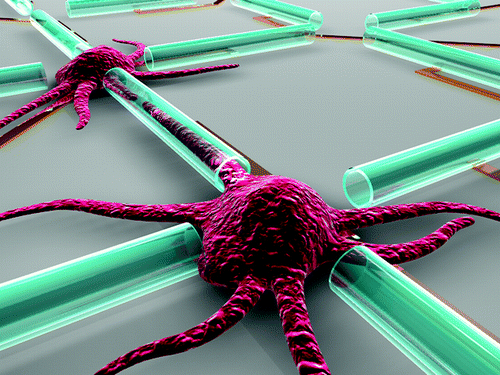March 22, 2011 report
New science suggests we might soon be able to mix computers and neurons

(PhysOrg.com) -- Graduate students at the University of Wisconsin, Madison, led by Minrui Yu and Yu Huang, have published an ACS Nano paper, "Semiconductor Nanomembrane Tubes: Three-Dimensional Confinement for Controlled Neurite Outgrowth," in which they show that they have been able to successfully coax nerve cell tendrils to grow through tiny tubes made of the semi-conductor materials silicon and germanium. While this ground-breaking research may not portend cyborgs or even human brains enmeshed with computer parts, it does open the door to the possibility of regenerating nerve cells damaged due to disease or injury.
The team, led by Justin Williams, a biomedical engineer, created tubes of varying sizes and shapes, small enough for a nerve cell to glam on to, but not so big that it could fit all the way inside. The tubes were then coated with nerve cells from mice and then watched to see how they would react. Instead of sitting idly, the nerve cells began to send tendrils through the tunnels, as if searching for a path to something or somewhere else. In some instances they actually followed the contours of the tubes, which means, in theory, that the nerves could be grown into structures.
Scientists have known for a while that nerve cells have a seek feature, but aren’t yet sure what it is they are seeking or if it’s just a random thing they do. By setting up nerve cells to follow pre-planned paths through tiny tubes, the research team hopes to find the answer to that by installing listening devices to record electrical emissions from nerves, which could in theory lead to recorded conversations between nerve cells.
The hope of course, in this type of research, is that a way can be found to connect a computer of some sort to a group of nerve cells to reestablish communication that has been disrupted. The computer in this case could serve as a relay of sorts, allowing those who can no longer walk, for example, due to spinal injury or disease, regain their former abilities. In that regard, this particular research is even more revealing than it might at first seem, due to the fact that the tiny tubes that have been created, very closely resemble myelin, the outer insulating sheath that covers parts of normal nerve cells.
More information: Semiconductor Nanomembrane Tubes: Three-Dimensional Confinement for Controlled Neurite Outgrowth, ACS Nano, Article ASAP. DOI:10.1021/nn103618d
© 2010 PhysOrg.com
















